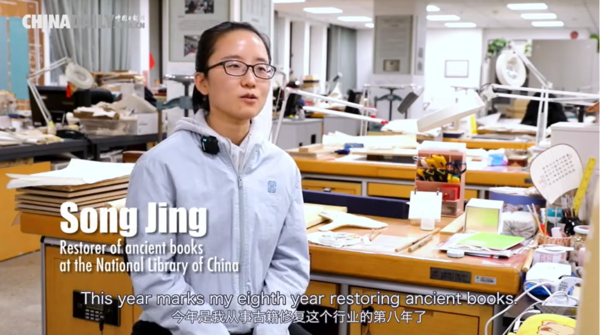 |
| Click the photo and watch the video. |
Keeping ancient manuscripts in tip-top condition requires expertise and passion, report Yang Feiyue and Wang Kaihao.
Whenever Song Jing visits a museum, she makes a point of checking out the section on ancient books. In addition to appreciating the wisdom hidden in those historical volumes, she focuses on how they were bound and presented.
"It's more like a force of habit caused by my job," says Song, 34, who has been working in the restoration division for ancient books at the National Library of China in Beijing for eight years. This entails studying and digging into unique binding methods she hasn't seen before, while evaluating the skills of masters who bring those paper treasures to light.
"You can tell the craftsmanship from the subtlety in the degrees of consistency in the paper's texture and color," Song says.
The National Library of China is home to about 3 million ancient books, which in China are defined as manuscripts, books and documents predating 1911, the year the monarchy ended.
The seasons come and go outside this workshop on the first floor of the library, but time is relative for Song and her fellow restorers. Their work is calculated not through "years" but "lifetimes". Day after day, the 10 or so specialists are fully immersed in the duty of handling and healing the old books. The flow of time may be hardly felt, except through the yellowing pages and the graying of hair.
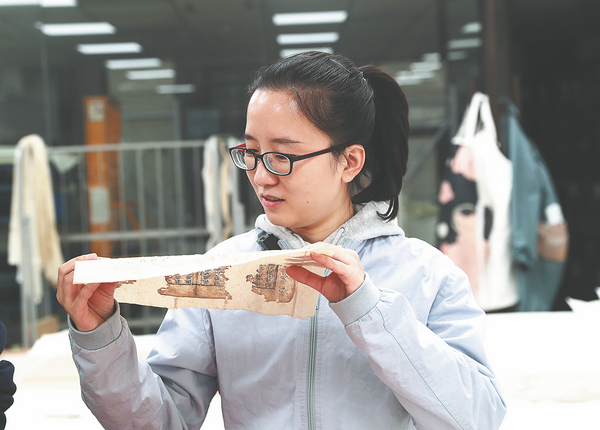 |
| Song Jing examines a restored page from an ancient document. [Zou Hong/China Daily] |
Song made her way to the ancient books division after finishing her cultural relic protection studies at Peking University in 2015. She has been engaged in restoring more than 100 ancient cultural relics, including writings by Emperor Qianlong and Empress Dowager Cixi from the Qing Dynasty (1644-1911).
The process of repairing ancient books is complex and time-consuming.
Song and the other restorers have to check in at 8:30 am every day to prepare before starting their restoration work about an hour later.
"The paste needs to be mixed right before the repair, otherwise it will go bad if it sits for too long," she explains.
"Also, the paste density varies for different tasks, which requires preparation on site."
She adds that pastes for sticking together paper and silk are different. Moreover, the restoration tools have to be checked to ensure they are cleaned thoroughly.
"If there's some residual paste on the brush, it can become hard and there is a risk it might pierce the paper," Song says.
After all is ready, restoration work can go on for seven to eight hours.
Before starting a restoration project, Song and her colleagues evaluate the subject. They have to consider what problems can be solved through restoration and those that cannot, and assess how the restoration process might potentially undermine the item.
"For example, there are many mold spots or stains on ancient paintings, and some of them are really deep, so we need to judge if the paper fiber will be compromised after their removal," Song says. "It all depends on specific cases."
In the worst cases, Song could find dozens of damaged areas on just one page of an ancient book.
"We have to create pieces of similar paper to patch them up while trying to make it as neat as possible," she says. "It is challenging and, sometimes, I even end up dreaming about the repairs."
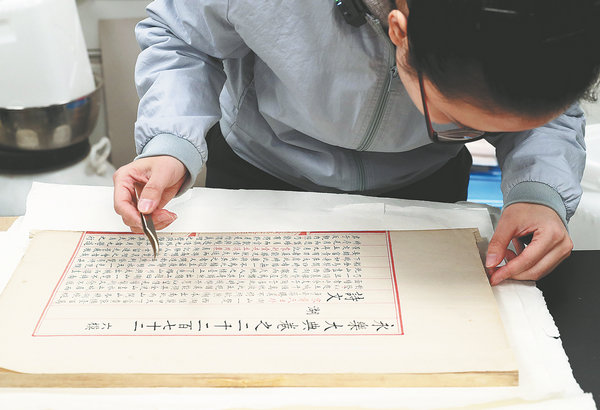 |
| Song Jing restores the ancient classic Yongle Dadian, using tweezers. [Zou Hong/China Daily] |
A Doctor of Paper Treasures
The primary objective of ancient book restoration is to extend the life span of the document. The higher the similarity between the original and the restoration materials, the more consistent their rate of aging will be, and thus the better the ancient books can be preserved.
At the moment, Song and her colleagues are working on restoring a copy of Yongle Dadian, an encyclopedia completed in 1408 after being commissioned by Emperor Yongle during the Ming Dynasty (1368-1644).
It is estimated that Yongle Dadian, which comprises 22,937 volumes in 11,095 books, contains some 370 million Chinese characters. It is said to be the world's largest paper-based encyclopedia in ancient history.
Time has taken its toll, and only about 400 books of a 16th-century duplicate, or just more than 3.5 percent of the total publication, are known to exist, while the whereabouts of the original version is unknown.
After receiving the challenge at the beginning of last year, it took Song and her colleagues six months of assessment before they started the restoration work.
They had to figure out ways to simulate the original raw materials for binding and layout through meticulous study.
"Most books from Yongle Dadian that have survived until today have suffered damage to their original binding," Song says.
"To restore them to their original form, we need to gather information from various sources, such as images and texts, before we can make a conclusion as to their original binding style and repair them accordingly," she explains.
Moreover, the ancient encyclopedia's silk texture and color have both grown inconsistent, which makes creating the necessary raw materials and matching the color difficult.
"It could only be settled through trial and error, and we had to make sure the repair materials were pretreated to emulate the similar aged condition as the original," Song explains.
In the past, restorers had to rely on their experience to determine the appropriate materials to use on a project.
"When I first learned restoration, my teacher would ask us to identify the material used to make a piece of paper by hand," Song recalls.
As technology has evolved, Song and her colleagues are able to make use of a new method of fiber analysis through microscopes to identify the raw materials with accuracy and efficiency.
However, the old-fashioned, tactile detection methods still come in handy when fibers are not readily available.
"After all, getting fiber samples might undermine the integrity of an ancient item," she says.
After the analysis is finished, restorers at the library can create paper that is incredibly similar to the original.
However, technology is only an auxiliary resource in the trade, and ancient-book restoration still requires a set of essential manual skills, ranging from concocting paste, cutting and brushing paper, and binding.
Fearing the chemicals in commercially produced pastes might harm the books, Song and her colleagues have to make the glues they need by themselves, starting from extracting starch from flour.
It requires a lot of practice before getting all of them down to a fine art, Song says.
For example, the paste viscosity cannot be too weak or too strong. "Otherwise, it can't hold the paper together or will make the paper crease," Song says.
The restoration also requires high levels of control in brushing the paper.
"If the pressure is not properly controlled during the brushing process, the paper may tear, but if the touch is too light, the paper won't adhere," Song explains.
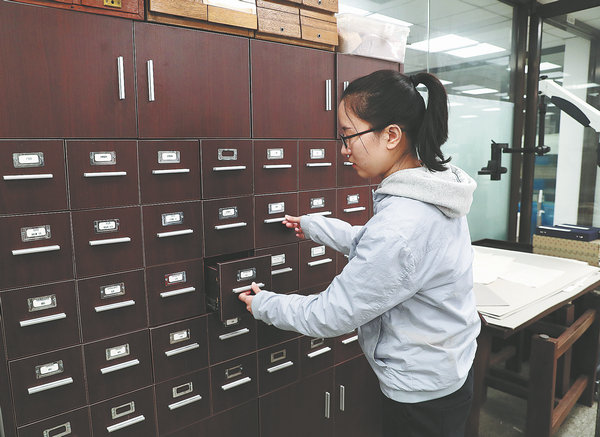 |
| Song Jing checks materials from a pigment cabinet. [Zou Hong/China Daily] |
A Dream Come True
Despite the arduous nature of the work, Song was determined to join the field from an early age.
As a child, Song was captivated by documentaries about the world's cultural relics and became deeply intrigued by the art of artifact restoration.
"I was amazed by how the gray and dusty lumps unearthed from below the ground turned out to be delicate and stunning items," she says.
Song spent hours researching cultural relics, frequenting local museums and reading related books.
In senior middle school, those earlier experiences helped her to set her sights on becoming a master restorer of ancient books.
There were not many schools offering cultural-relic restoration courses back then, and her dream destination, Peking University, only offered openings every other year.
"It wasn't recruiting students in my graduation year," she says.
As Song looked into undergraduate curricula arrangement for that particular field of study, she found it was mostly related to chemistry. Therefore, she opted to start a chemistry degree at Fudan University in Shanghai, enrolling in 2008. In the interim, she continued to read up on cultural relics and study how museums operate.
"I got to learn how certain aspects of chemistry are going a long way in restoring cultural relics," she says.
Her dedication and hard work paid off when, after graduating from Fudan, she was accepted as a master's candidate to the prestigious cultural heritage preservation program at Peking University. From then on, she has been on a mission to make her dreams a reality.
Song spent most of her first year at work developing basic restoration skills and learning by observing her teachers at work.
She has, for instance, learned to never place a cup of water on the worktable nor wear high heels at work. "They might expose ancient books to hazards," she says.
She has also ensured that she uses a board to carry precious books, which are fragile and could be deformed if held, she explains.
"These professional habits must be developed from the beginning so that they become second nature," Song says.
In ancient book restoration, undoing work is generally not an option, as any redoing can cause further damage to the cultural artifact. "Therefore, every step must be thoroughly thought through before being executed," she emphasizes.
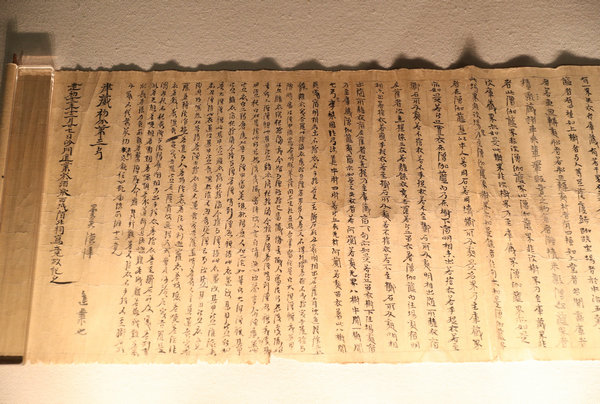 |
| A manuscript written in AD 417 from Dunhuang, Gansu Province, is part of a collection of ancient documents in the National Library of China. [Zou Hong/China Daily] |
Intangible Heritage
The ancient books preservation technique of the national library was listed as a national-level intangible cultural heritage in 2008.
Nonetheless, Du Weisheng, a senior ancient books conservator in the library, who has been devoted to this career for nearly 50 years, points out that ancient book restoration involves knowledge from multiple disciplines beyond traditional expertise.
In addition to possessing excellent restoration skills, a restorer must also have a certain level of understanding in fields such as physics, chemistry, printing and papermaking, Du says.
"In the context of improving cultural confidence, the valuable ancient books that have been preserved serve as the best evidence of that confidence," Du says. "Restoring these books is a significant effort in prolonging the life of ancient Chinese civilization."
The more ancient books Song restores, the more fun she has found in her line of work.
During the restoration process, she sometimes comes across surprising discoveries.
In 2021, she found some text faintly visible under the blue background of a painting featuring the image of a Buddha when it was dampened.
The text roughly conveyed the artist's intentions, and was hidden again when the paper dried.
It usually takes at least two to three years from learning and following a master, before one can independently lead a restoration project.
Years of practice has taught her to respect everything from the pages, as any fragment could hold a record of key historical information. In Yongle Dadian's case, she would collect every scrap of paper during restoration for further analysis in the lab.
One time, Song even caught an actual bookworm alive amid the pages. She showed mercy for the creature despite it being an enemy to the books she loves, feeding it with paper.
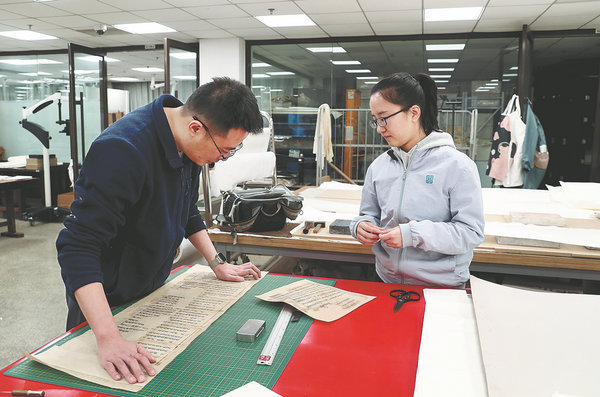 |
| Song discusses ancient book repair methods with her colleague Xie Jincheng. [Zou Hong/China Daily] |
Such unexpected surprises have thrilled her as if she was connected with ancient people across time and space.
With the country focusing heavily on the popularization of cultural relics and TV programs, such as Masters in the Forbidden City gaining wide acclaim, over the years, the public has shown an increasingly strong interest in the field.
"Ancient Chinese civilization has left behind a vast number of books, many of which require restoration before they can see the light of day again," Song says.
Song has joined the talent development team and entered the campus with her experienced colleagues to deliver lectures, carry out training, and guide college students looking to gain practical experience.
"It's important to try to understand an industry from as many aspects as possible, before you decide if it's just a fleeting interest or a burning passion," Song says.
"Hopefully, I can be of some help in inspiring more young people to find their lifelong passion in the field of cultural heritage preservation."
Yu Xiaoou contributed to this story.
(Source: China Daily)